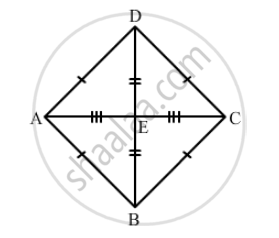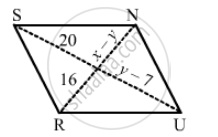Advertisements
Advertisements
Question
Show that each diagonal of a rhombus bisects the angle through which it passes.
Solution

\[\text{ In ∆ AED and ∆ DEC }: \]
\[ AE = EC (\text{ diagonals bisect each other })\]
\[AD = DC (\text{ sides are equal })\]
\[DE = DE (\text{ common })\]
\[\text{ By SSS congruence }: \]
\[ ∆ AED \cong ∆ CED\]
\[\angle ADE = \angle CDE (\text{ c . p . c . t })\]
\[\text{ Similarly, we can prove ∆ AEB and ∆ BEC, ∆ BEC and ∆ DEC, ∆ AED and ∆ AEB are congruent to each other } . \]
\[\text{ Hence, diagonal of a rhombus bisects the angle through which it passes } . \]
\[\]
APPEARS IN
RELATED QUESTIONS
The following figure is parallelogram. Find the degree value of the unknown x, y, z.

In the following figure GUNS and RUNS are parallelogram. Find x and y.

Two opposite angles of a parallelogram are (3x − 2)° and (50 − x)°. Find the measure of each angle of the parallelogram.
ABCD is a parallelogram in which ∠A = 70°. Compute ∠B, ∠C and ∠D.
All the angles of a quadrilateral are equal to each other. Find the measure of each. Is the quadrilateral a parallelogram? What special type of parallelogram is it?
ABCD is a rhombus and its diagonals intersect at O.
(i) Is ∆BOC ≅ ∆DOC? State the congruence condition used?
(ii) Also state, if ∠BCO = ∠DCO.
Which of the following statement is true for a rectangle?
Its diagonals are equal and bisect each other.
Lengths of diagonals of a rhombus ABCD are 16 cm and 12 cm. Find the side and perimeter of the rhombus.
In rhombus ABCD;
(i) if ∠A = 74° ; find ∠B and ∠C.
(ii) if AD = 7.5 cm ; find BC and CD.
A quadrilateral whose all sides are equal, opposite angles are equal and the diagonals bisect each other at right angles is a ______.
